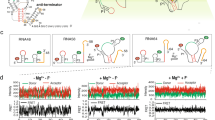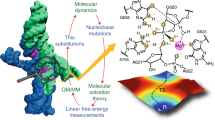Abstract
Large ribozymes require divalent metal ions to fold. We show here that the tertiary structure of the Tetrahymena group I intron P4-P6 domain nucleates around a magnesium ion core. In the domain crystal structure, five magnesium ions bind in a three-helix junction at the centre of the molecule. Single atom changes in any one of four magnesium sites in this three-helix junction destroy folding of the entire 160-nucleotide P4-P6 domain. The magnesium ion core may be the RNA counterpart to the protein hydrophobic core, burying parts of the RNA molecule in the native structure.
This is a preview of subscription content, access via your institution
Access options
Subscribe to this journal
Receive 12 print issues and online access
$189.00 per year
only $15.75 per issue
Buy this article
- Purchase on Springer Link
- Instant access to full article PDF
Prices may be subject to local taxes which are calculated during checkout
Similar content being viewed by others
References
Dill, K.A. Dominant forces in protein folding. Biochemistry 29, 7133–7155 (1990).
Michel, F. & Westhof, E. Modelling of the three-dimensional architecture of group I catalytic introns based on comparative sequence analysis. J. Mol. Biol. 216, 585–610 (1990).
Loria, A. & Pan, T. Domain structure of the ribozyme from eubacterial ribonuclease P. RNA 2, 551–563 (1996).
Pyle, A.M. Ribozymes: a distinct class of metalloenzymes. Science 261, 709–714 (1993).
Cole, P.E., Yang, S.K. & Crothers, D.M. Conformational changes of transfer ribonnucleic acid: Equilibrium phase diagrams Biochemistry 11, 4358–4368 (1972).
Banerjee, A.R., Jaeger, J.A. & Turner, D.H. Thermal unfolding of a group I ribozyme: the low-temperature transition is primarily disruption of tertiary structure. Biochemistry 32, 153–163 (1993).
Zarrinkar, P.P. & Williamson, J.R. Kinetic intermediates in RNA folding. Science 265, 918–924 (1994).
Robillard, G.T., Tarr, C.E., Vosman, F. & Reid, B.R. A nuclear magnetic resonance study of secondary and tertiary structure in yeast tRNA Phe. Biochemistry 16, 5261–5273 (1977).
Pley, H.W., Flaherty, K.M. & McKay, D.B. Three-dimensional structure of a hammerhead ribozyme. Nature 372, 68–74 (1994).
Scott, W.G., Murray, J.B., Arnold, J.R.P., Stoddard, B.L. & Klug, A. Capturing the structure of a catalytic RNA intermediate: the hammerhead ribozyme. Science 274, 2065–2069 (1996).
Celander, D.W. & Cech, T.R. Visualizing the higher order folding of a catalytic RNA molecule. Science 251, 401–407 (1991).
Doherty, E.A. & Doudna, J.A. The P4-P6 domain directs higher order folding of the Tetrahymena ribozyme core. Biochemistry 363, 159–3169 (1997).
Downs, W.D. & Cech, T.R. Kinetic pathway for folding of the Tetrahymena ribozyme revealed by three UV-inducible crosslinks. RNA 2, 718–732 (1996).
Murphy, F.L. & Cech, T.R. An independently folding domain of RNA tertiary structure within the Tetrahymena ribozyme. Biochemistry 32, 5291–5300 (1993).
Cate, J.H. et al. Crystal structure of a group I ribozyme domain: Principles of RNA packing. Science 273, 1678–1685 (1996).
Cate, J.H. & Doudna, J.A. Metal binding sites in the major groove of a large ribozyme domain. Structure 4, 1221–1229 (1996).
Cate, J.H. et al. RNA tertiary structure mediation by adenosine platforms. Science 273, 1696–1699 (1996).
Christian, E.L. & Yarus, M. Analysis of the role of phosphate oxygens in the group I intron from Tetrahymena. J Mol. Biol. 228, 743–758 (1992).
Pecoraro, V.L., Hermes, J.D. & Cleland, W.W. Stability constants of Mg2+ and Cd2+ complexes of adenine nucleotides and thionucleotides and rate constants for formation and dissociation of Mg–ATP and Mg–ADP. Biochemistry 23, 5262–5271 (1984).
Murphy, F.L. & Cech, T.R. GAAA tetraloop and conserved bulge stabilize tertiary structure of a group I intron domain. J Mol. Biol. 236, 49–63 (1994).
Gish, G. & Eckstein, F. DNA and RNA sequence determination based on phosphorothioate chemistry. Science 240, 1520–1522 (1988).
Frey, P.A. & Sammons, R.D. Bond order and charge localization in nucleoside phosphorothioates. Science 228, 541–545 (1985).
Hinrichs, W., Steifa, M., Saenger, W. & Eckstein, F. Absolute configuration of Rp-uridine 3′,5′-cyclic phosphorothioate. Nucleic Acids Res. 15, 4945–4955 (1987).
Jack, A., Ladner, J.E., Rhodes, D., Brown, R.S. & Klug, A. A crystallographic study of metal-binding to yeast phenylalanine transfer RNA. J. Mol. Biol. 111, 315–328 (1977).
Holbrook, S.R., Sussman, J.L., Warrant, R.W., Church, G.M. & Kim, S.-H. RNA-ligand interactions: (I) magnesium binding sites in yeast tRNAPhe. Nucleic Acids Res. 4, 2811–2820 (1977).
Waldburger, C.D., Schildbach, J.F. & Sauer, R.T. Are buried salt bridges important for protein stability and conformational specificity? Nature Struct. Biol. 2, 122–128 (1995).
Hendsch, Z.S. & Tidor, B. Do salt bridges stabilize proteins? A continuum electrostatic analysis. Prot. Sci. 3, 211–226 (1994).
Hendsch, Z.S., Jonsson, T., Sauer, R.T. & Tidor, B. Protein stabilization by removal of unsatisfied polar groups: computational approaches and experimental tests. Biochemistry 35, 7621–7625 (1996).
Jaeger, J.A., Zuker, M. & Turner, D.H. Melting and chemical modification of a cyclized self-splicing group I intron: similarity of structures in 1 M Na+, in 10 mM Mg2+, and in the presence of substrate. Biochemistry 29, 10147–10158 (1990).
Wang, J.-F. & Cech, T.R. Metal ion dependence of active-site structure of the Tetrahymena ribozyme revealed by site-specific photo-cross-linking. J. Am. Chem. Soc. 116, 4178 (1994).
Christian, E.L. & Yarus, M. Metal coordination sites that contribute to structure and catalysis in the group I intron from Tetrahymena. Biochemistry 32, 4475–4480 (1993).
Strobel, S.A. & Shetty, K. Defining the chemical groups essential for Tetrahymena group I intron function by nucleotide analog interference mapping. Proc Natl. Acad. Sci. U.S.A. 94, 2903 (1997).
Joyce, G.F., van der Horst, G. & Inoue, T. Catalytic activity is retained in the Tetrahymena group I intron despite removal of the large extension of element P5. Nucleic Acids Res 17, 7879–7889 (1989).
Laggerbauer, B., Murphy, F.L. & Cech, T.R. Two major tertiary folding transitions of the Tetrahymena catalytic RNA. EMBO J. 13, 2669–2676 (1994).
van der Horst, G., Christian, A. & Inoue, T. Reconstitution of a group I intron self-splicing reaction with an activator RNA. Proc. Natl. Acad. Sci. USA 88, 184–188 (1991).
Lehnert, V., Jaeger, L., Michel, F. & Westhof, E. New loop-loop tertiary interactions in self-splicing introns of subgroup 1C and ID - A complete 3D model of the Tetrahymena thermophila ribozyme. Chem. & Biol. 3, 993–1009 (1996).
Zarrinkar, P.P. & Williamson, J.R. The P9.1-P9.2 peripheral extension helps guide folding of the Tetrahymena ribozyme. Nucleic Acids Res. 24, 854 (1996).
Coleman, J.E. Zinc proteins: enzymes, storage proteins, transcription factors and replication proteins. Annu. Rev. Biochem. 61, 897–946 (1992).
Wu, L.C., Schulman, B.A., Peng, Z. & Kim, P.S. Disulfide determinants of calcium-induced packing in alpha-lactalbumin. Biochemistry 35, 859–863 (1996).
Brünger, A. X-PLOR Manual, Version 3.1: A System for X-ray Crystallography and NMR (Yale University Press, New Haven, Connecticut; 1993).
Collaborative Computing Project, N.4. The CCP4 suite: programs for protein crystallography. Acta Crystallogr.. D 50, 760–763 (1994).
Doudna, J.A., Grosshans, C., Gooding, A. & Kundrot, C.E. Crystallization of ribozymes and small RNA motifs by a sparse matrix approach. Proc Natal. Acad Sci USA 90, 7829–7833 (1993).
Carson, M. Ribbons 2.0. J. Appl. Crystallogr. 24, 958–961 (1991).
Author information
Authors and Affiliations
Rights and permissions
About this article
Cite this article
Cate, J., Hanna, R. & Doudna, J. A magnesium ion core at the heart of a ribozyme domain. Nat Struct Mol Biol 4, 553–558 (1997). https://doi.org/10.1038/nsb0797-553
Received:
Accepted:
Issue Date:
DOI: https://doi.org/10.1038/nsb0797-553
This article is cited by
-
The Emergence of Life
Space Science Reviews (2019)
-
RNA with iron(II) as a cofactor catalyses electron transfer
Nature Chemistry (2013)
-
Fluoride ion encapsulation by Mg2+ ions and phosphates in a fluoride riboswitch
Nature (2012)
-
RNA’s coming of age as a drug target
Journal of Inclusion Phenomena and Macrocyclic Chemistry (2009)
-
RNA switches function
Nature (2006)



